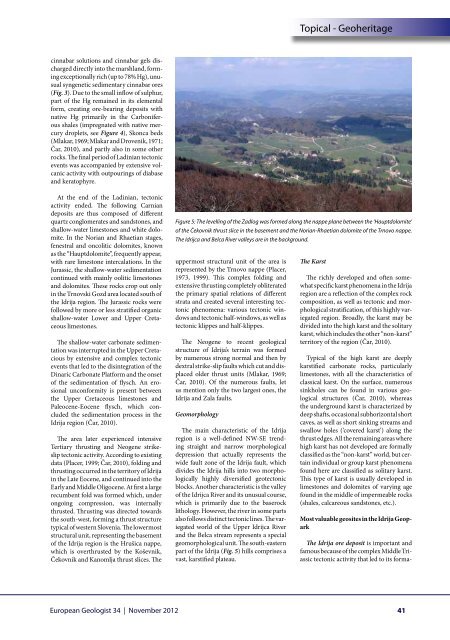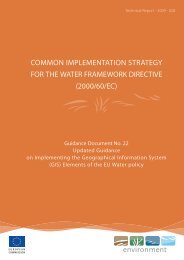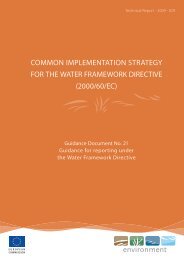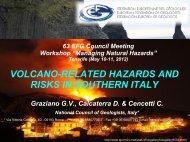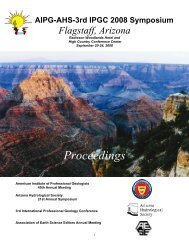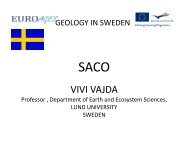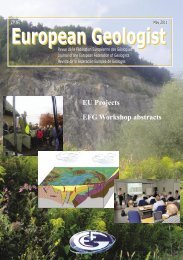European Geologist European Geologist Geoheritage - learning ...
European Geologist European Geologist Geoheritage - learning ...
European Geologist European Geologist Geoheritage - learning ...
Create successful ePaper yourself
Turn your PDF publications into a flip-book with our unique Google optimized e-Paper software.
Topical - <strong>Geoheritage</strong><br />
cinnabar solutions and cinnabar gels discharged<br />
directly into the marshland, forming<br />
exceptionally rich (up to 78% Hg), unusual<br />
syngenetic sedimentary cinnabar ores<br />
(Fig. 3). Due to the small inflow of sulphur,<br />
part of the Hg remained in its elemental<br />
form, creating ore-bearing deposits with<br />
native Hg primarily in the Carboniferous<br />
shales (impregnated with native mercury<br />
droplets, see Figure 4), Skonca beds<br />
(Mlakar, 1969; Mlakar and Drovenik, 1971;<br />
Čar, 2010), and partly also in some other<br />
rocks. The final period of Ladinian tectonic<br />
events was accompanied by extensive volcanic<br />
activity with outpourings of diabase<br />
and keratophyre.<br />
At the end of the Ladinian, tectonic<br />
activity ended. The following Carnian<br />
deposits are thus composed of different<br />
quartz conglomerates and sandstones, and<br />
shallow-water limestones and white dolomite.<br />
In the Norian and Rhaetian stages,<br />
fenestral and oncolitic dolomites, known<br />
as the “Hauptdolomite”, frequently appear,<br />
with rare limestone intercalations. In the<br />
Jurassic, the shallow-water sedimentation<br />
continued with mainly oolitic limestones<br />
and dolomites. These rocks crop out only<br />
in the Trnovski Gozd area located south of<br />
the Idrija region. The Jurassic rocks were<br />
followed by more or less stratified organic<br />
shallow-water Lower and Upper Cretaceous<br />
limestones.<br />
The shallow-water carbonate sedimentation<br />
was interrupted in the Upper Cretacious<br />
by extensive and complex tectonic<br />
events that led to the disintegration of the<br />
Dinaric Carbonate Platform and the onset<br />
of the sedimentation of flysch. An erosional<br />
unconformity is present between<br />
the Upper Cretaceous limestones and<br />
Paleocene-Eocene flysch, which concluded<br />
the sedimentation process in the<br />
Idrija region (Čar, 2010).<br />
The area later experienced intensive<br />
Tertiary thrusting and Neogene strikeslip<br />
tectonic activity. According to existing<br />
data (Placer, 1999; Čar, 2010), folding and<br />
thrusting occurred in the territory of Idrija<br />
in the Late Eocene, and continued into the<br />
Early and Middle Oligocene. At first a large<br />
recumbent fold was formed which, under<br />
ongoing compression, was internally<br />
thrusted. Thrusting was directed towards<br />
the south-west, forming a thrust structure<br />
typical of western Slovenia. The lowermost<br />
structural unit, representing the basement<br />
of the Idrija region is the Hrušica nappe,<br />
which is overthrusted by the Koševnik,<br />
Čekovnik and Kanomlja thrust slices. The<br />
Figure 5: The levelling of the Zadlog was formed along the nappe plane between the ‘Hauptdolomite’<br />
of the Čekovnik thrust slice in the basement and the Norian-Rhaetian dolomite of the Trnovo nappe.<br />
The Idrijca and Belca River valleys are in the background.<br />
uppermost structural unit of the area is<br />
represented by the Trnovo nappe (Placer,<br />
1973, 1999). This complex folding and<br />
extensive thrusting completely obliterated<br />
the primary spatial relations of different<br />
strata and created several interesting tectonic<br />
phenomena: various tectonic windows<br />
and tectonic half-windows, as well as<br />
tectonic klippes and half-klippes.<br />
The Neogene to recent geological<br />
structure of Idrija’s terrain was formed<br />
by numerous strong normal and then by<br />
dextral strike-slip faults which cut and displaced<br />
older thrust units (Mlakar, 1969;<br />
Čar, 2010). Of the numerous faults, let<br />
us mention only the two largest ones, the<br />
Idrija and Zala faults.<br />
Geomorphology<br />
The main characteristic of the Idrija<br />
region is a well-defined NW-SE trending<br />
straight and narrow morphological<br />
depression that actually represents the<br />
wide fault zone of the Idrija fault, which<br />
divides the Idrija hills into two morphologically<br />
highly diversified geotectonic<br />
blocks. Another characteristic is the valley<br />
of the Idrijca River and its unusual course,<br />
which is primarily due to the baserock<br />
lithology. However, the river in some parts<br />
also follows distinct tectonic lines. The variegated<br />
world of the Upper Idrijca River<br />
and the Belca stream represents a special<br />
geomorphological unit. The south-eastern<br />
part of the Idrija (Fig. 5) hills comprises a<br />
vast, karstified plateau.<br />
The Karst<br />
The richly developed and often somewhat<br />
specific karst phenomena in the Idrija<br />
region are a reflection of the complex rock<br />
composition, as well as tectonic and morphological<br />
stratification, of this highly variegated<br />
region. Broadly, the karst may be<br />
divided into the high karst and the solitary<br />
karst, which includes the other “non-karst”<br />
territory of the region (Čar, 2010).<br />
Typical of the high karst are deeply<br />
karstified carbonate rocks, particularly<br />
limestones, with all the characteristics of<br />
classical karst. On the surface, numerous<br />
sinkholes can be found in various geological<br />
structures (Čar, 2010), whereas<br />
the underground karst is characterized by<br />
deep shafts, occasional subhorizontal short<br />
caves, as well as short sinking streams and<br />
swallow holes (‘covered karst’) along the<br />
thrust edges. All the remaining areas where<br />
high karst has not developed are formally<br />
classified as the “non-karst” world, but certain<br />
individual or group karst phenomena<br />
found here are classified as solitary karst.<br />
This type of karst is usually developed in<br />
limestones and dolomites of varying age<br />
found in the middle of impermeable rocks<br />
(shales, calcareous sandstones, etc.).<br />
Most valuable geosites in the Idrija Geopark<br />
The Idrija ore deposit is important and<br />
famous because of the complex Middle Triassic<br />
tectonic activity that led to its forma-<br />
<strong>European</strong> <strong>Geologist</strong> 34 | November 2012<br />
41


